This articles has been updated in February 2024 by Alison Bailey, the original article by Wendy Tibbitts can be found below.
Marie-Louise von Motesiczky (1906-1996) in Amersham
Thanks to the Marie-Louise von Motesiczky Trust, Amersham Museum has a collection of six paintings by this widely acclaimed Expressionist European artist which were painted during the 1940s and 50s when she was living in Amersham.
All images are copyright of the Marie-Louise von Motesiczky Charitable Trust.
Marie-Louise von Motesiczky created over three hundred paintings, mainly portraits, self-portraits and still-lifes, in a career that lasted over 60 years. After achieving recognition late in life, many of these works now hang in major public collections throughout the world, more than achieving her own ambition that: “if you could only paint a single good picture in your lifetime, your life would be worthwhile”.
Marie-Louise von Motesiczky arrived in Amersham in 1940. She was 34. Her aristocratic family was of Jewish heritage, displaced by the onset of war. In 1938 she fled her native Vienna, directly after the Anschluss, the annexation of Austria by the Nazis, and travelled via Amsterdam and London to Amersham. In unfamiliar surroundings, she created a new life for herself in a small cottage on Amersham Common.
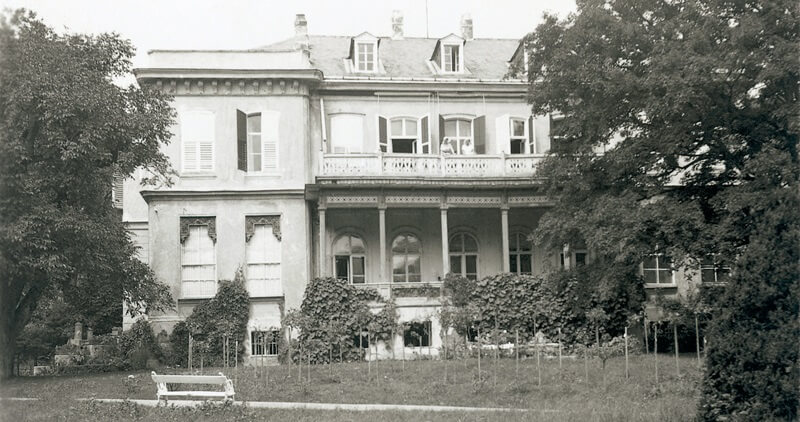
The Artist
Marie-Louise grew up in Vienna with her older brother Karl and her mother Henriette, surrounded by the city’s intellectual and cultural elite. Her father, Edmund, an accomplished cellist, died when Marie-Louise was only three.

From an early age she pursued her interest in painting, particularly portraiture. She first took classes in Paris and then The Hague where she was inspired by Vincent van Gogh’s paintings. When she was 21, she studied under the renowned artist Max Beckmann or Max Beckmann – Wikipedia in Frankfurt. A family friend, he remained an important influence throughout her life. She continued her art studies in Berlin, living the bohemian artistic life to the full, before returning to Vienna to establish her own studio. In January 1939 Marie-Louise held her first solo exhibition at the Esher Surrey Gallery at The Hague, which was extensively reviewed and well received. This could have launched her professional career much earlier if war had not intervened.
The Motesiczky Family in Amersham
Marie-Louise arrived in England early 1939, with her mother, Henriette and Marie Hautpmann (1884-1954), her childhood nanny. She painted Marie in Girl by the Fire, 1941 and in a full-length posthumous portrait, Marie in Doorway, 1950s. Marie took on the role of housekeeper. She was very close to Marie-Louise and helped take care of Henriette, who suffered from frequent bouts of ill health and could be very demanding. Marie-Louise’s paintings often feature her mother, latterly documenting her declining health. These paintings, widely acclaimed as her greatest works, are both an honest account of ageing, and a tender reflection of their close but complicated relationship.

Marie-Louise’s brother Karl remained in Nazi-occupied Vienna, but his resistance group was betrayed for helping Jewish families. He died in Auschwitz in 1943. Marie-Louise painted a poignant double portrait of Karl and his girlfriend, After the Ball, 1949.
Initially the family lived in Hampstead, where there was a thriving émigré community but soon, they decided to leave London during the Blitz. On the advice of Marie-Louise’s friend, the Czech sculptor Mary Duras (1884-1982), they chose Amersham. It was within easy reach of London on the Metropolitan Line, so Marie-Louise could remain in touch with friends in the city.
The Motesiczkys found lodgings with recently widowed Lottie Meakin at a house then called Edale, on Stubbs Wood (now 41 Stubbs Wood) overlooking the Chess Valley. Her husband, Walter Meakin, had been a Labour Party member, and a founding member of the National Union of Journalists.
Cornerways
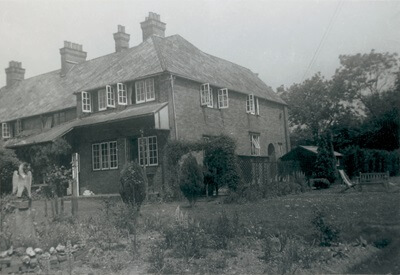
Although the Motesiczkys arrived with only a few possessions, in 1940 they could afford to buy Cornerways, an end of terrace cottage, in a row of three, on the corner of Chestnut Lane and Chestnut Close. There was a large garden which wrapped around the house and backed on to a public footpath.
Henriette recorded her first impressions of the house: “from the outside it appears totally unassuming, I fell in love with the interior and the arrangement of the rooms. It really was so totally right for us – we could not have found anything better.”

Karl sent some of the family’s belongings, enabling them to furnish their new home with familiar items. Henriette describes the location of Dutch and German paintings, a Russian rug, an inlaid desk and dining table, and large, dark wood wardrobes. It was a simple home elevated with their expensive and ornate objects.
Karl also managed to send some of Marie-Louise’s paintings, which she kept in her studio, formerly the sitting room. This was a large room with a fireplace and three windows overlooking the large garden. The household included Marie’s black cat, Susi, portrayed in Cat with Flowers, 1949 and the first of many dogs, Philip, a corgi who is represented, running at full speed, in Morning in the Garden, 1943.
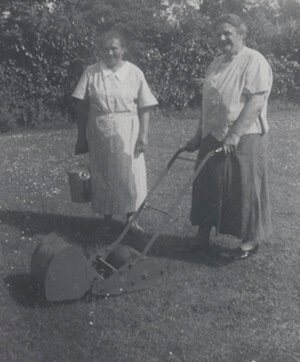
The garden wrapped around the house, with a lawn tennis court, vegetable garden and fruit trees. The Motesiczkys continued to grow vegetables, which they stored in a lean-to by the house. They used the tennis net to cordon off the orchard, creating a pen for 15 chickens to roam. In the summer guests would relax in deckchairs or the comfortable garden hammock.
Marie-Louise often painted the garden. Whilst based in reality, and sometimes portraying family members, these mysterious scenes are often allegorical, dreamlike and hard to decipher. This fantasy element perhaps expresses Marie-Louise’s feelings of alienation as an exile in quintessentially British Amersham.
An Émigré Community
The Motesiczkys’ Amersham home, filled with Viennese furniture, the smell of Marie’s baking, and where German was the first language, was an echo of a lost Vienna to their émigré friends.
Perhaps the biggest influence in Marie-Louise’s life was the writer and later Nobel Laureate, Elias Canetti, whom Marie-Louise met in London. Their intimate and complex relationship benefited her work but caused her great sadness. Canetti and his wife, Veza, followed Marie-Louise to Chesham Bois, taking lodgings with Father Milburn at Durris, next to the Meakin’s home on Stubbs Wood. Marie-Louise housed Canetti’s collection of two thousand books at Cornerways and supported the couple financially. Marie-Louise portrayed Canetti in numerous paintings including Study of Canetti Reading, 1945.

Other visitors included the poet and anthropologist, Franz Baermann Steiner and Oskar Kokoschka, the German Expressionist artist, who had known Marie-Louise in Vienna. An important influence on her work, particularly the development of her more expressionist style, he encouraged her to exhibit her paintings in Britain and to establish her career here.
Marie-Louise referred to Elias Canetti and Oskar Kokoschka as her ‘Hauptgötter’, her main gods, together with her mother and Max Beckmann.
Chestnut Lane
Cornerways was located on an unmade country lane with no streetlights or pavements. The road finished at Quill Hall Farm, which was surrounded by fields and views of the Chess Valley. There was one pub, The Red Lion, where the landlords were John and Elsie Howlett and a small shop, Chestnut Stores, run by Ernest and Henrietta Gough, which sold newspapers and groceries.

Henriette described her first impressions of Chestnut Lane: “It is situated in a calm, shady street in which, thank God, there are no elegant villas but only small inconspicuous little houses and large meadows and gardens which belong to large estates. An old dairy with wonderful, age-old chestnut trees, grazing cows and horses is opposite us. Also quite close is a pub, from where you can carry very warm beer across the road in the summer.”
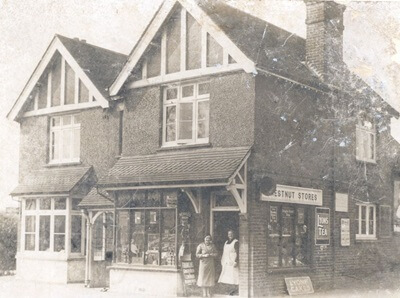
The small dairy farm, on a large plot almost opposite Cornerways, was the Chestnuts, run by Edgar and Dorothy Sladen with their daughter Cassie. Dorothy suffered from bouts of depression and was painted by Marie-Louise in Woman from Chestnut Lane,1957.
Elengeni was an elegant country house, hidden by trees down the long drive portrayed in Snow Drift with Gate, 1940s. This was the home of Irma Colenso, who spoke fluent German, and her husband, the architect Angelo Crovo. The house was built in 1901 by Irma’s parents Frank and Sophie Colenso. Frank’s father was Bishop John Colenso, the radical Bishop of Natal. Like all her family Irma Colenso was a social campaigner and anti-colonialist activist. She may have introduced Marie-Louise to the West African students, Frederick Kankam Boadu and Joe Appiah, photographed in the garden of Cornerways, who participated in the Fifth Pan-African Congress in Manchester in 1945.
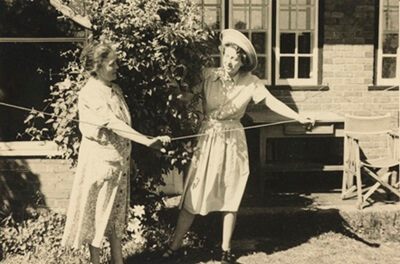
Giorgia Pearce’s Music Studio in Chestnut Close was just yards from Marie-Louise’s home. Italian composer Francesco Ticciati also lived here and organised lectures and classical concerts, attended by Marie-Louise and Canetti. These featured other local émigré artists, such as pianist, Constance Dupré, classical singer, Frieda Danziger and concert pianist, Ippolit Motchaloff. Eric Newton, an art critic who later supported Marie-Louise’s work, was married to Giorgia Pearce’s daughter, Stella.
The residents of Chestnut Lane were Marie-Louise’s direct community, the people she would have walked past and greeted, or seen in the local shop or pub. She made some close friends, such as Peggy (Margaret) Harris, who lived on neighbouring New Road and enjoyed recitals and cultural evenings at the Music Studio on Chestnut Close.
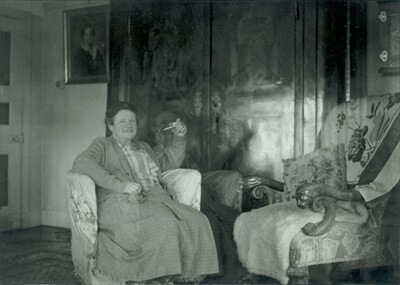
After the war Marie-Louise moved back to London, where she lived until her death in 1996. Her mother and Marie carried on living in the house in Amersham with Marie-Louise visiting most weekends and continuing to paint there. After suffering a series of strokes, Marie died in 1954. Henriette was becoming increasingly frail, and after Marie-Louise bought a large house in Chesterford Gardens, Hampstead, she moved there in 1960. Cornerways was rented out and eventually sold in the 1970s after planning permission was granted for two new bungalows in the garden.
Professional success
Encouraged by Oskar Kokoschka, Marie-Louise contributed several paintings to émigré artists’ exhibitions during the 1940s, whilst living in Amersham. In 1943 she joined the Artis’ International Association, contributing paintings to their exhibitions, and in 1944 the Czechoslovak Institute held an Exhibition of Painting and Sculpture by Marie-Louise Motesiczky and Mary Duras with both artists’ work reflecting their experience of exile and isolation. Oskar Kokoschka made an unsuccessful attempt to get the Tate to purchase some of Marie-Louise’s pictures from this exhibition.
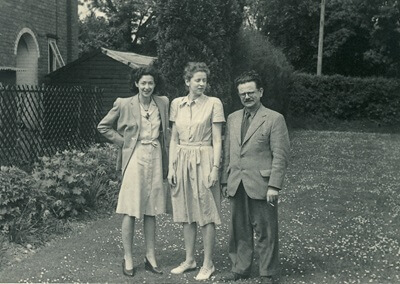
Marie-Louise became a naturalised British Citizen in 1948 but it took far longer for her to achieve the professional recognition she deserved in her adopted country. In 1985 she had a retrospective exhibition in London at the Goethe-Institut when she was hailed as a major discovery and a “dazzling talent”. Her series of paintings of Henriette in her old age were particularly acclaimed. In 1994, she was honoured with a solo exhibition by the Belvedere in Vienna, finally confirming her status as an important Austrian painter of the 20th century. According to her obituary in the Independent newspaper this exhibition was better attended than any previous exhibition of contemporary art.
Marie-Louise never needed to sell her work and always found it difficult to let go of her ‘children’ as she called her paintings. After her death, most of her work passed to the charitable trust that she had recently established. The trust organised a centenary exhibition in 2006-07 which toured from Tate Liverpool to Frankfurt, Vienna and Southampton, published a biography in 2007, and a catalogue raisonné in 2009. The trust has now distributed much of her work among public collections in the UK, Ireland, Austria, Germany, Holland and the United States to ensure that her legacy continues. In London her worked can be viewed at the National Portrait Gallery, Bugh House, the Ben Uri Gallery and Museum, the British Museum, The Freud Museum, the Garden Museum, and Tate, which also holds her archive.
Amersham Museum Paintings (with photos)
Three Heads, 1944
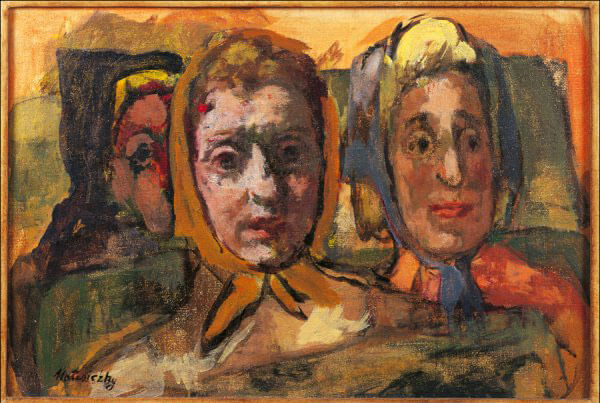
Like The Travellers (1940), which was Marie-Louise’s first painting after arriving in Britain, this later painting expresses more of the alienation and sadness of exile. The heads of three women appear to be reflected in the front window of a Green Line bus. The central head is a self-portrait which is more clearly defined than the more sketchily painted heads of the other passengers, based on her mother and aunt Ilse Leembruggen. According to Ines Schlenker’s Catalogue Raisonné: “there is no interaction between the three figures which adds to the overall air of despondency and anonymity”.
Snow Drift with Gate, early 1940s
This winter landscape with snow sparkling in the sunshine was painted from inside Cornerways looking across Chestnut Lane at the drive, field, trees, and hedges of the Elangeni estate. This was the home of Angelo and Irma Crovo née Colenso. This painting was exhibited as Winter Landscape at the Czechoslovak Institute in 1944.
Deckchair in the Garden, 1940s
This atmospheric painting shows a view of the deserted garden at Cornerways at sunset, from an open ground floor window, probably in Marie-Louise’s studio. A small red bird flies above an empty deckchair surrounded by white and purple irises. Tall trees loom above the garden hedge.
Woman from Chestnut Lane,1957

This is a portrait of Dorothy Sladen (1887-1966) who lived at The Chestnuts, a small dairy farm situated in a large plot almost opposite Cornerways with her husband, Edgar (1882-1968), and daughter Cassie (1908-2005). She suffered from bouts of depression and when Marie-Louise painted her, she noted that she was teaching her to paint as therapy. She rarely left the house and is depicted surrounded by plants from her garden.
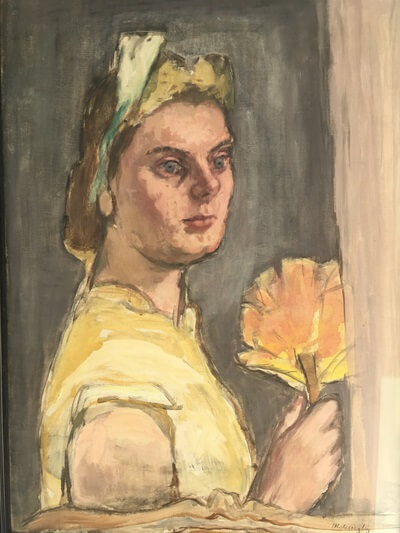
Dorothy, 1945, Amersham Museum
Referred to both as Dorothy and Dary in her letters, it’s most likely that she worked as a cleaner for the Motesiczkys.
She is depicted as though passing by an open door, with the bottom of the painting framed by an ornate piece of furniture. She appears to be holding a duster and has a distant, far away look in eyes.
Marie in Doorway, after 1954, Amersham Museum
Marie-Louise painted this affectionate portrait of Marie-Hautpmann (1884-1954), her ‘second mother’ in commemoration after her death. Ritschie, as Marie-Louise called her was her childhood nanny and life-long friend. She first came to the family as Marie-Louise’s wet nurse after she fell pregnant as an unmarried servant girl and her own daughter, Hilda, was brought up by relatives. Marie is portrayed in good health before she had suffered several strokes and had a leg amputated. She is wearing practical work clothes as if she has been working in the garden with the scythe and pitchfork included in the painting but the butterflies and flowers surrounding her and the transparency of the figure add a mystical element.
Other Amersham Faces (with photos)
Marie-Louise created portraits of a wide range of people she met in Amersham.
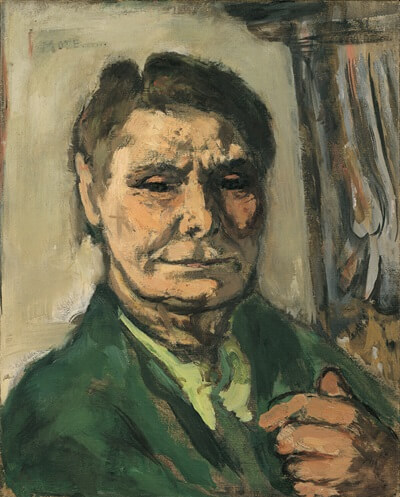
Mrs Beazly, 1941, Museum Boijmans van Beuningen, Rotterdam
Little is known about Mrs Beazly, but she may have been Amy Beasley, a retired elementary school headmistress and spinster, who lived at nearby Plantation Road. She has strong features, and her age is reflected in her wrinkled forehead and lined face.
Old Woman, Amersham, 1942, Tate
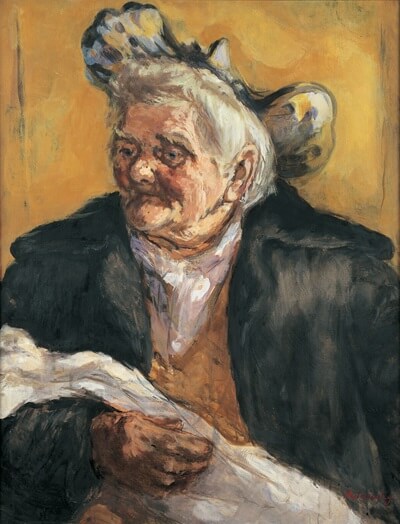
In a letter to Elias Canetti in 1942, Marie-Louise described the sitter in this portrait as a neighbour, who had worked as a nurse or doctor and lived to 100 years old. The woman is dressed in black and holds a white sheet, which could reflect the Dutch tradition of incorporating a shroud to suggest that the sitter would outlive those around her.
Marie-Louise gives us further clues about the sitter, whose age and suffering is reflected in her features:
“I have painted it with a lot of devotion…and I was afraid that such old women would not exist for much longer and that I must quickly immortalise her one last time exactly as she is. It was as if her face said…‘And although my husband was run over 40 years ago and although my favourite daughter died…I am not for the feverite Is this how she spells it? ones’
Although there is evidence of a few centenarians in Amersham in the 1940s, it’s not possible to find one living on Chestnut Lane or nearby. We would love to discover who she was!
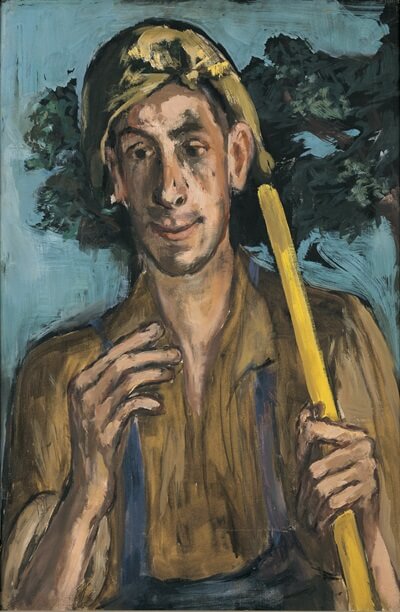
The Gardener, 1945, (private collection)
This young man is assumed to be the Motesiczky’s gardener in Amersham. He is shown in his work clothes, holding a tool, maybe a broom or hoe in his right hand, and in his left he shows us something he’s found and wants to share.
Woman with Blue Parrot, 1948, Amsterdam Stedelijk Museum of Modern Art

This portrait shows an elderly woman called Henriette, her long grey hair tied back, drinking tea, with a striking blue parrot seated beside her. She is believed to have been the housekeeper for Mr Albert, an émigré from Vienna.
Marie-Louise discusses the progress of the painting in her letters to Elias Canetti in April and May 1948. She describes the weekly sittings:
“Henriette is fine for me. She sits badly but she talks so much amusing nonsense and I paint and it is like old times with models in Vienna.”
Nicolas Lytton, 1956, private collection

This painting depicts Marie-Louise’s cousin, Nicolas von Lieben, who anglicised his name after moving to England. He served as a junior officer in the war and afterwards lived near Amersham and often visited the Motesiczkys. He enjoyed horse riding and is shown holding a riding whip.
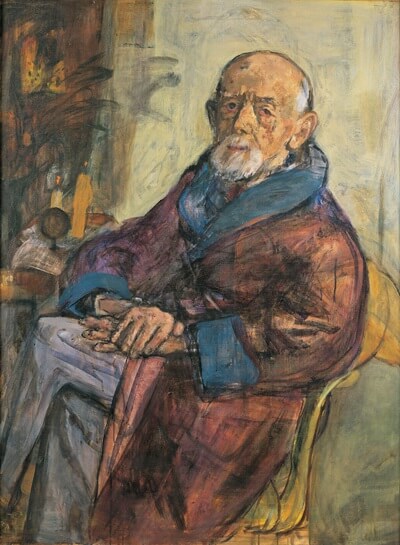
Father Milburn, 1958, Österreichische Galerie Belvedere, Vienna
The Motesiczkys’ first lived at Edale on Stubbs Wood. Next door was Durris, the home of Robert Gordon Milburn, a retired Anglican priest, and his wife Mary where the Canettis lived. Father Milburn is shown as a calm and distinguished older man, wearing a red house coat, sitting in a relaxed pose.

Frau Saaler, 1942, Amsterdam Stedelijk Museum of Modern Art
Not much is known about Frau Saaler’s identity, but it’s assumed she was an émigré whom Marie-Louise met in Amersham. She is well-dressed for her portrait, wearing a fur coat with brooch, a chunky necklace and earrings. This is in contrast to the simple clothes of some of Marie-Louise’s other Amersham sitters.
Sources/Further reading
The Undiscovered Expressionist, a life of Marie-Louise von Motesiczky, Jill Lloyd
Party in the Blitz, the English Years, Elias Canetti
Marie-Louise von Motesiczky 1906-1996, Catalogue Raisonné, Ines Schlenker
Obituary: Marie-Louise von Motesiczky | The Independent | The Independent
Motesiczky.org
The Insightful Émigré – Tate Etc | Tate
Marie-Louise von Motesiczky | National Galleries of Scotland
Marie-Louise von Motesiczky – The Women’s Art Collection : The Women’s Art Collection (cam.ac.uk)
ML-Von-Motes-1st-draft-CdeC-CB-10-Jan.pdf (bucksgardenstrust.org.uk)
This is the original article written by Wendy Tibbitts for the Amersham Society/Amersham Museum newsletter and is reproduced here with permission.

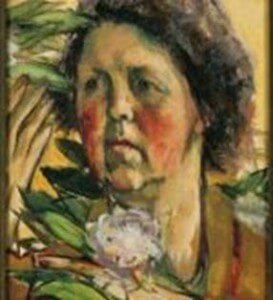
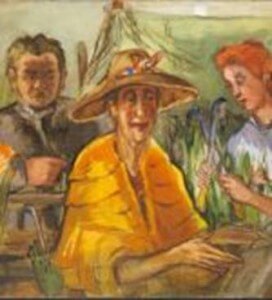
In 1941, on the corner of Chestnut Lane and Chestnut Close, stood 86 Chestnut Lane, otherwise known as ‘Cornerways’. The house belonged to the artist Marie-Louise von Motesiczky, and her Mother, Henriette. They lived there with their Housekeeper, Marie Hauptmann, until around 1950. It had a large garden where they kept chickens and grew vegetables. The house still exists, but a more recent dwelling has taken over the corner position.
Marie-Louise von Motesiczky was born into the cultural high society of Vienna in 1906. In her wealthy family’s social circles she mixed with the creative elite of her day. As a teenager she was greatly impressed with a regular visitor, the German artist Max Beckmann, who encouraged her artistic inclination and mentored her for the rest of his life. She took art lessons in Holland, Germany and Paris, and was influenced by a variety of artists but strove to develop an individual style. After the Nazi’s invaded Austria, she and her Mother, fled to Holland , but after a few months emigrated to Britain, where Marie Hauptmann, their long-time housekeeper, joined them. After living in hotels and rented accommodation they moved to Amersham and lodged in Stubbs Wood, Chesham Bois. Marie-Louise’s biographer says they stayed with the Rev. Gordon Milburn in ‘Durris’, but Elias Canetti in his book “Party in the Blitz” recalls visiting Marie-Louise when she was living at Mrs Meakin’s in Stubbs Wood. The wealth that Marie-Louise had been born into was gradually diminishing, and they were forced to leave most of their possessions in Vienna, however they had sufficient funds to buy ‘Cornerways’, and Marie-Louise was able to paint full-time and not rely on the sale of her paintings for income. In fact, at that time, she still felt she was developing her style, and was reluctant to sell her paintings. The spacious sitting room on the ground floor of ‘Cornerways’ was her studio.
The Motesiczky’s house in Amersham had many notable visitors, including the painter, Oskar Kokoschka, and the Nobel-prize winning writer Elias Canetti and his wife. The Canetti’s, who were fellow émigrés, had met the Motesiczkys in London and had followed them to Amersham where they lived out the war years with Gordon Milburn. It was the start of a very close life-long friendship between Marie-Louise and Elias. Marie-Louise painted “Father Milburn” in 1958.
Marie-Louise’s proximity to the Music Studio in Chestnut Close meant that she would occasionally attend some of the cultural evenings there. In Mabel Brailsford’s diary for September 1942, Mabel recalls that the artist had just finished a portrait of the composer and pianist, Francesco Ticciati, “all but the suit”. Later that month Mabel was shown the portrait at a London concert where Ticciati was playing. Mabel disliked the portrait because she said painting him with “his mouth open wipes out all the nobility from his face”, and she described Marie-Louise as “a dainty cap-a-pie looking little person with a very ‘I keep myself to myself’ manner – the last person you would expect to perpetrate such a coarse unpleasant daub”. (The diary was published by Amersham Museum in 2016.) Marie-Louise was also at the concert. The following day the portrait was returned to Marie-Louise, by the organiser of the concert. It is not known what became of this painting as it is not listed among her known works.
Marie-Louise became a British citizen in 1948 and later moved to Hampstead where she remained until her death in 1996. Her paintings are hanging in the National Portrait Gallery, the Tate and leading art galleries around the world.
Read more in an article by Alison Bailey, Two Talented Women Artists in Exile during WWII.

